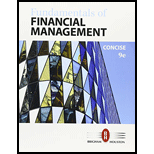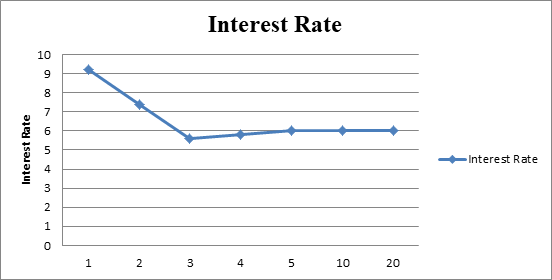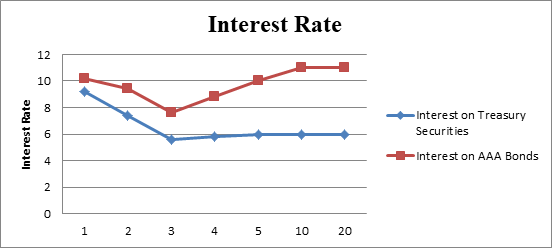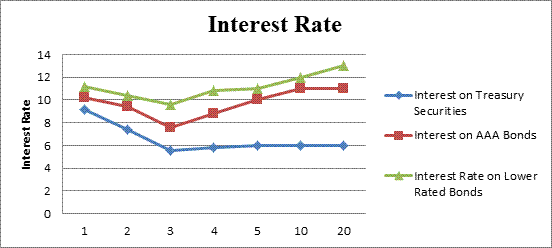
Concept explainers
a.
To identify: The interest on Treasury securities, and yield curve.
Yield:
Yield is the percentage of securities at which the return is provided by the company to its investors. Yield can be there in the form of dividend and interest.
Yield Curve:
The graphical representation of the expected return, provided by the company to its investors during the years is known as the yield curve.
a.
Answer to Problem 18P
The items required for the calculation of interest rate are the real risk-free rate, inflation rate, and maturity risk premium.
Explanation of Solution
Given,
The risk free rate is 2% or 0.02.
Inflation rate for the first year is 7% or 0.07.
The inflation rate of second year is 5% or 0.05.
The inflation rate after two years is 3% or 0.03.
The maturity risk premium for the first year is 0.2% or 0.002 and it will increase by 0.2% every year till 1%.
Formula to calculate the interest rate,
Where,
- r is the corporate bond yield.
- r* is the risk free rate.
- IP is the inflation premium.
- MRP is the maturity risk premium.
Statement to show the calculation of interest rate
| Maturity |
Real Risk-Free Rate (%) (r*) |
Inflation Rate (%) (IP) |
Maturity Risk Premium (MRP) |
Interest Rate on Treasury Bond
|
| 1 | 2 | 7 | 0.2 | 9.20 |
| 2 | 2 | 5 | 0.4 | 7.40 |
| 3 | 2 | 3 | 0.6 | 5.60 |
| 4 | 2 | 3 | 0.8 | 5.80 |
| 5 | 2 | 3 | 1 | 6 |
| 10 | 2 | 3 | 1 | 6 |
| 20 | 2 | 3 | 1 | 6 |
Table (1)
The yield curve of the given data

Fig 1
- The x-axis represents the maturity.
- The y-axis represents the interest rate.
- The interest rates with their respective time period can be shown from the graph.
Hence, the interest of 1-year treasury securities is 9.20%, at 2-year treasury securities is 7.60%, 3-year treasury securities is 5.60%, 4-year treasury securities is 5.80% and thereafter is 6%.
b.
To identify: The interest rate on AAA rated securities, and the yield curve.
b.
Answer to Problem 18P
The items required for the calculation of interest rate are real risk-free rate, inflation rate, and maturity risk premium.
Explanation of Solution
Explanation:
Given,
The risk free rate is 2% or 0.02.
Inflation rate for the first year is 7% or 0.07.
The inflation rate of second year is 5% or 0.05.
The inflation rate after two years is 3% or 0.03.
The maturity risk premium for the first year is 0.2% or 0.002 and it will increase by 0.2% every year till 1%.
The default risk premium is 1% which increases
Formula to calculate the interest rate,
Where,
- r is the corporate bond yield.
- r* is the risk free rate.
- IP is the inflation premium.
- MRP is the maturity risk premium.
- DRP is the default risk premium.
Statement to show the calculation of interest rate
| Maturity |
Real Risk-Free Rate (%) (r*) |
Inflation Rate on Treasury Bond (%) (IP) |
Maturity Risk Premium (%) (MRP) |
Interest Rate on Treasury Bond
|
Default Risk Premium (%) (DRP) |
Interest Rate on AAA rated Bonds
|
| 1 | 2 | 7 | 0.2 | 9.20 | 1 | 10.20 |
| 2 | 2 | 5 | 0.4 | 7.40 | 2 | 9.40 |
| 3 | 2 | 3 | 0.6 | 5.60 | 2 | 7.60 |
| 4 | 2 | 3 | 0.8 | 5.80 | 3 | 8.80 |
| 5 | 2 | 3 | 1 | 6 | 4 | 10 |
| 10 | 2 | 3 | 1 | 6 | 5 | 11 |
| 20 | 2 | 3 | 1 | 6 | 5 | 11 |
Table (2)
The yield curve of the given data

Fig 2
- The x-axis represents the maturity.
- The y-axis represents the interest rate.
- The interest rates of treasury securities and AAA bonds with their respective time period can be shown from the graph.
Hence, the interest of 1-year AAA bond is 10.20%, at 2-year AAA bond is 9.40%, 3-year AAA bond is 7.60%, 4-year AAA bond is 8.80% 5-year AAA bond is 10% and thereafter it is 11%.
c.
To identify: The interest rate on lower rated bonds, and the yield curve.
c.
Answer to Problem 18P
The items required for the calculation of interest rate are the inflation rate, real risk-free rate, and maturity risk premium.
Explanation of Solution
Given,
The risk free rate is 2% or 0.02.
Inflation rate for the first year is 7% or 0.07.
The inflation rate of second year is 5% or 0.05.
The inflation rate after two years is 3% or 0.03.
The maturity risk premium for the first year is 0.2% or 0.002 and it will increase by 0.2% every year till 1%.
The default risk premium is 1% which increases
Formula to calculate the interest rate,
Where,
- r is the corporate bond yield.
- r* is the risk free rate.
- IP is the inflation premium.
- MRP is the maturity risk premium.
- DRP is the default risk premium.
Statement to show the calculation of interest rate on AAA rated bonds
| Maturity |
Real Risk-Free Rate (%) (r*) |
Inflation Rate on Treasury Bond (%) (IP) |
Maturity Risk Premium (%) (MRP) |
Default Risk Premium (%) (DRP) |
Interest Rate
|
| 1 | 2 | 7 | 0.2 | 1 | 10.20 |
| 2 | 2 | 5 | 0.4 | 2 | 9.40 |
| 3 | 2 | 3 | 0.6 | 2 | 7.60 |
| 4 | 2 | 3 | 0.8 | 3 | 8.80 |
| 5 | 2 | 3 | 1 | 4 | 10 |
| 10 | 2 | 3 | 1 | 5 | 11 |
| 20 | 2 | 3 | 1 | 5 | 11 |
Table (3)
Statement to show the calculation of interest rate on lower rated bonds
| Maturity |
Real Risk-Free Rate (%) (r*) |
Inflation Rate on Treasury Bond (%) (IP) |
Maturity Risk Premium (%) (MRP) |
Default Risk Premium on Lower rated Bonds (%) (DRP) |
Interest Rate (%)
|
| 1 | 2 | 7 | 0.2 | 2 | 11.2 |
| 2 | 2 | 5 | 0.4 | 3 | 10.40 |
| 3 | 2 | 3 | 0.6 | 4 | 9.60 |
| 4 | 2 | 3 | 0.8 | 5 | 10.80 |
| 5 | 2 | 3 | 1 | 5 | 11 |
| 10 | 2 | 3 | 1 | 6 | 12 |
| 20 | 2 | 3 | 1 | 7 | 13 |
Table (4)
The yield curve of the given data

Fig 2
- The x-axis represents the maturity.
- The y-axis represents the interest rate.
- The interest rates of Treasury securities, AAA bonds and lower rated bonds with their respective time period can be shown from the graph.
Hence, the interest of 1-year lower rated bond is 11.20%, at 2-year lower rated bond is 10.40%, 3-year lower rated bond is 9.60%, 4-year lower rated bond is 10.80% 5-year lower rated bond is 11%, 10-year lower rated bond is 12% and thereafter is 13%.
Want to see more full solutions like this?
Chapter 6 Solutions
Fundamentals of Financial Management, Concise Edition
- What is the effect of compounding interest?A. It decreases total interest earned over timeB. It keeps the interest constantC. It increases interest earned over time by earning interest on interestD. It applies only to loans, not investmentsarrow_forwardWhat is the effect of compounding interest?A. It decreases total interest earned over timeB. It keeps the interest constantC. It increases interest earned over time by earning interest on interestD. It applies only to loans, not investments need answer !!arrow_forwardi need help in this question!What is the primary goal of corporate finance?A. Maximize salesB. Minimize costsC. Maximize shareholder wealthD. Maximize employee satisfactionarrow_forward
- What is the primary goal of corporate finance?A. Maximize salesB. Minimize costsC. Maximize shareholder wealthD. Maximize employee satisfactionhelp me please !arrow_forwardWhat is the primary goal of corporate finance?A. Maximize salesB. Minimize costsC. Maximize shareholder wealthD. Maximize employee satisfactionarrow_forwardWhat does the price-to-earnings (P/E) ratio indicate?a) The total debt of a companyb) The market value relative to earningsc) The return on equityd) The efficiency of company operationshelp in thisarrow_forward
- What does the price-to-earnings (P/E) ratio indicate?a) The total debt of a companyb) The market value relative to earningsc) The return on equityd) The efficiency of company operationsarrow_forwardWhich of the following is an example of equity financing?a) Issuing bondsb) Taking out a bank loanc) Selling shares of stockd) Borrowing from a financial institutionplease answer step by step.arrow_forwardNo ai. Which of the following is an example of equity financing?a) Issuing bondsb) Taking out a bank loanc) Selling shares of stockd) Borrowing from a financial institutionarrow_forward
- Which of the following is an example of equity financing?a) Issuing bondsb) Taking out a bank loanc) Selling shares of stockd) Borrowing from a financial institutionarrow_forwardThe Efficient Market Hypothesis (EMH) suggests that:a) Stock prices are predictableb) The market always prices securities perfectlyc) Investors can consistently beat the marketd) Securities are always overvaluedarrow_forwardThe Efficient Market Hypothesis (EMH) suggests that:a) Stock prices are predictableb) The market always prices securities perfectlyc) Investors can consistently beat the marketd) Securities are always overvaluedhelp me!!arrow_forward
 EBK CONTEMPORARY FINANCIAL MANAGEMENTFinanceISBN:9781337514835Author:MOYERPublisher:CENGAGE LEARNING - CONSIGNMENT
EBK CONTEMPORARY FINANCIAL MANAGEMENTFinanceISBN:9781337514835Author:MOYERPublisher:CENGAGE LEARNING - CONSIGNMENT Intermediate Financial Management (MindTap Course...FinanceISBN:9781337395083Author:Eugene F. Brigham, Phillip R. DavesPublisher:Cengage Learning
Intermediate Financial Management (MindTap Course...FinanceISBN:9781337395083Author:Eugene F. Brigham, Phillip R. DavesPublisher:Cengage Learning

